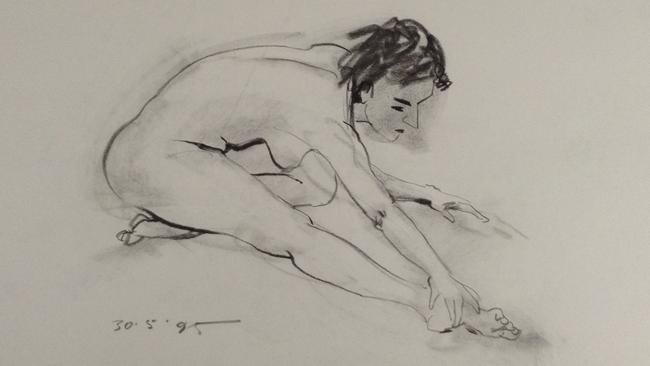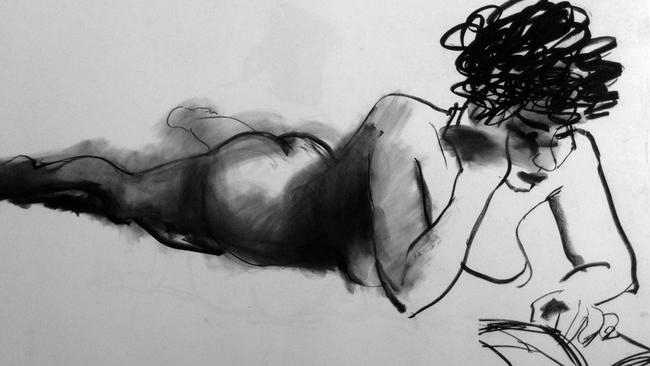Bill Leak: naked ambition
Colourful, controversial, chaotic; the late Bill Leak, much-loved cartoonist at The Australian, was an old-school artist and art student.

“Art alone in the language of art.”
Of all the alumni to emerge from the Julian Ashton Art School in Sydney during the past 142 years, few adhered as strictly to its founding policy, above, as Bill Leak did.
Throughout the 40 years after his brief stint at Ashton’s in the mid-1970s, his benchmark for art was not the words of critics or the pretentious theories emerging from New York’s trendiest galleries but whether the language of art alone had been successfully used to communicate an element of truth.
After Ashton’s, where he learned the fundamentals of observation and draftsmanship through life drawing, he briefly attended another school run by John Ogburn, a devotee of Matisse. And that was it. That was all the formal training he ever received.
Two years later, aged 22, he flew to Europe on a one-way ticket to directly absorb what he could from the old masters. Having been raised in the bush and the suburbs, where great art was mostly accessible only through reproductions in books, he was thrilled to finally be able to engorge on centuries of work, and with typical suburban pragmatism could not see any need for a pedagogic middle man.

In letters to his family, he described his response to paintings by Picasso, Rembrandt, Delacroix, Hals and others in the Louvre, Pompidou, Rijksmuseum and so on. The letters are remarkable for their lack of analysis. He was either “knocked out” by a painting, indifferent to it or, as in the case of German Expressionism, one of the most humourless movements of the 20th century, suffered a headache from being exposed to it. But even then he resisted the urge to try to work out why.
At a time when art theory and fashion were key determinants of success, Leak remained obstinately true to the Ashton maxim. Either a piece of art worked or it didn’t. This wasn’t Leak defying fashion; it would be more accurate to say he was simply oblivious to it.
Twenty years later, he returned to life drawing, this time for slightly different reasons. His marriage had recently broken down, he was succumbing again to the alcoholism that would bedevil him for the rest of his life, and his repeated failed attempts to win the Archibald Prize, despite portraiture being his unequivocal forte, were reaching their famously frustrating nadir.
If his work from this period is any indication, the life-drawing sessions were rare moments of serenity in a life that was at the time descending into chaos.
Ralph Steadman, who illustrated the books by gonzo journalist Hunter S. Thompson and was one of Leak’s early heroes, once said that he never threw out any of his own drawings. “I keep everything – every piece of paper – or I sell it,” he said. “But I keep it more often and if I find it by chance, I believe it to contain imagined properties which crave to be seen.”

Leak felt the same about his life drawings, an aspect of his art that is virtually unknown by the public. He hoarded much of it over the years, and even signed and dated some pieces, obviously believing their “imagined properties” would one day show themselves.
Curator Ross Heathcote, who happens to be an old friend of Leak’s younger brother Graeme, has, with Leak’s son Johannes, selected a series of drawings for a remarkably revelatory exhibition starting this month at the Manly Art Gallery, Sydney.
The drawings are mostly from Leak’s time at Ashton’s, later drawings of his first wife, Astrid, and his troubled period of the mid-1990s.
“They are deceptively simple,” Johannes says. “He’s not indicating form and solidity through tone as much as the descriptive quality of his lines. It looks easy but it’s incredibly instinctive. Drawing is a cerebral exercise. You are trying to apply all the things you’ve learned and all the things that influence you to the point where it becomes automatic, where you are not thinking about those things any more.”

One of those influences, subtly, is caricature – the bulbous bottom, the exaggerated pose, the model’s inappropriately coy expression. But Leak’s own life is also in these pictures, and the fact that life drawing was solace to him means the caricatures here are gentler than when he was drawing, say, former prime minister John Howard in a cartoon.
Of course, Leak’s cartoon caricatures were more extreme because, unlike with these models, he wasn’t afterwards seeking a more vigorous, tactile interaction with the subjects. But still there is an admirable restraint in these pictures, and even an affection for the imperfections or unique details he highlights.
“Whether it’s a mass of black hair, the curve of a back, the bum poking out, the flattening of the shoulders, a twist of the head, or whether it was the way the shoulders go one way and the bum goes another, he was so tuned in to little things that he could make more of,” Johannes says.
“You never want your drawing to undermine those things. If you do, you have boring drawings.
“With Dad, this is all happening at a level of high, automatic connection with the eyes.”

Perhaps this exercise, focusing on a woman’s body for purely cerebral purposes, was ironically a rare reprieve from the libidinousness that burdened most of his waking hours. It was certainly a break from the angry, duplicitous, incompetent Machiavellian characters who were the focus of his day job.
Charcoal too was a softer medium. Whereas his cartoons featured Steadman-esque splatters of black ink to depict spittle, skin blotches and darkened eyes, with these pictures you forget the lines are black at all.
Heathcote says that when he and Johannes were selecting the pieces, the first thing they often saw was something anatomically incorrect. But then “something good about it” would become apparent. Quite often it was the feeling of a fleeting moment when Bill’s influences, from Goya to Whiteley, came together.

Their spontaneity is their greatest quality. Again, this is contrary to most perceptions of Leak’s work. His cartoons were the result of excessive reading and workshopping, often over schooners of beer at the Aurora Hotel near News Corp’s office in Sydney, and his portraits are intense studies of character into which he poured much of his own joy and affection.
This exhibition adds another dimension to an artist, illustrator and cartoonist whose absence should be more keenly felt than it is. Despite his impressive output and robust defence of freedom of speech, his legacy is still less clearly defined than the women in these drawings.
“Archive is a serious word, and it doesn’t suit Bill,” Heathcote says. “This is the flotsam and jetsam of a life. We are spanning a few decades with these pictures and you see the change and the evolution in them, but ultimately there is a movement away from any kind of fashion. It’s just Bill, the model and his charcoal.”
Bill Leak: Life Drawing is on display at Manly Art Gallery and Museum, Sydney, February 28 to March 29. Fred Pawle is writing Bill Leak’s biography.

To join the conversation, please log in. Don't have an account? Register
Join the conversation, you are commenting as Logout